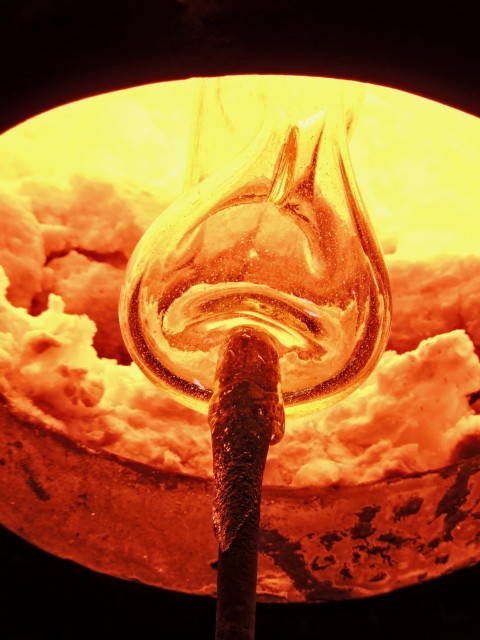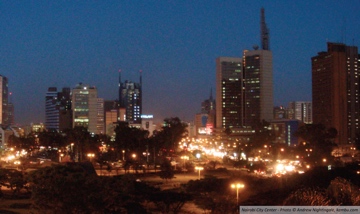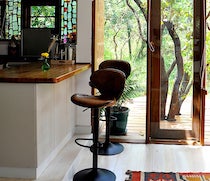Blowing Glass in Kitengela
After driving across the dry and dusty plains of Kitengela, arriving at Kitengela Hot Glass feels like stepping into a wonderland. This places makes a fun-filled day-trip from Nairobi - or why not stay longer in one of their lovely cottages?

‘In life, you cannot finish making glass. You can die and you still haven’t become perfect.’ Alexander – glass blower at Kitengela Hot Glass.
Colourful glass surrounds you as soon as you step into Kitengela Hot Glass, studding the gate, adorning the buildings and dangling from the trees. Quirky statues dot the landscape. Baubles decorate the flowerbeds, hanging from plants and draped over twigs.
The café is decorated with lustrous glass, and serves snacks on glass plates and drinks in glass carafes. The shop is lined with an array of glass that would draw the most ardent shopper up short: bottles, jugs, ornaments, chandeliers, tableware, jewellery and more are placed on shelves that stretch wall-to-wall across several rooms.
The heart of the place is, of course, the factory. Here, each piece of artwork is painstakingly created by hand. The flaming furnaces, focused workers and molten glass give a strange impression of having been transported to medieval times.
The team works on one item at a time, all taking their place in the chain of operations. All the men are capable of doing all the tasks on the production line, and they exchange tasks regularly. Watching this in operation is almost like watching a choreographed dance, as each man moves in synch with his teammates. One man is collecting glass from the furnace and blowing it; another is swinging glass to increase its length and pinching it; one more is rolling molten glass in coloured powder and adding a pattern; another is flattening the base and shaping it; the last two join their hot glass and exchange the holding position in order to cut and open the piece. When it’s finished, the item is placed in a cooling oven where it stays for 20 hours. 500°C might not seem cool, but it’s substantially cooler than the kiln from which the glass has come, which is kept at 1,100°C.
Alexander, who started work here in 2011, said, ‘Depending on the intellectual knowledge of the person, it can take three or four years to train. Before you become a glass blower, you’re an assistant. You’re cautious not to get burnt, you follow instructions, and you learn a lot from your leaders.’
Omosa, who started in 2000, said, ‘The job might seem easy, but it’s very challenging. It’s like life. You have to communicate with your hot glass. I miss it when I’m at home. I feel something is missing. We’re excited when we finish a piece. It’s like you’re a winner – you’ve scored a goal.’
Kitengela Hot Glass was started in the early 1990s by Anselm Croze, who still manages it to this day. Having done a glass blowing course in France, and followed that up with an apprenticeship at a studio in the Netherlands, Anselm returned to his homeland Kenya full of enthusiasm for his new craft. With the help of Finnish glassblower Mikko Merikallio who had started a glass business near Eldoret, he built his furnace. There was no electricity in Kitengela in those days, so – keen to recycle and reuse as much as possible – they crafted a steam-injected furnace that used recycled engine oil. Over the years, Anselm slightly modified this, but the factory still uses a similar system.
It’s not just the oil that’s recycled: to make their glass they collect old bottles, broken glasses, shattered windows. ‘We prefer window glass,’ says Anselm. ‘It’s stronger than other glass.’
Anselm lives and breathes the factory: talking to him is like a sped-up documentary on glass making. ‘When you melt glass you’re melting silica sand, which has a high melting point,’ he says. ‘You flux that, bringing the melting point down by adding a flux of various substances such as soda ash, or borax, or lead oxide. Glass has different expansion and shrinkage when it heats and cools; it’s different for every recipe.’
From a simple start making glass beads, the factory has gone from strength to strength. Anslem now creates custom-made pieces, bespoke signature items and huge public space installations. Using light, he works with architects to make windows, murals, mosaics and more. The factory now has a full metal workshop: by combining his techniques with wrought iron or concrete, Anselm crafts chairs, swings, coffee tables, shelves, fire-pits and even whole walls. He’s now commissioned by hoteliers, restaurateurs, interior decorators and – most recently – craft gin makers. Known around Kenya and beyond, the factory has become not just a business but a symbol of Kenya’s innovation and imagination.
Tamara Britten, 26 January 2022
Published also in: The Link; Safarilink's inflight magazine
About the region
Nairobi

Nairobi is a thriving, cosmopolitan hub of government offices, embassies, businesses, banks, churches, mosques, temples, shops, restaurants and markets. Attractions include the National Museum, Railway Museum, National Archives, Karen Blixen Museum and Bomas of Kenya. Nairobi is the world’s only capital city to boast a national park within its boundaries.
Read more about NairobiWhere to stay
Kitengela Hot Glass is renowned in Kenya for its innovative and colourful hand-blown glass. Founded in the early 1990s by Anselm Croze, the place is a wonderland of lustrous statues, chandeliers, tableware, and jewellery. The factory with its flaming furnaces, and adjoining shop and café, ...
